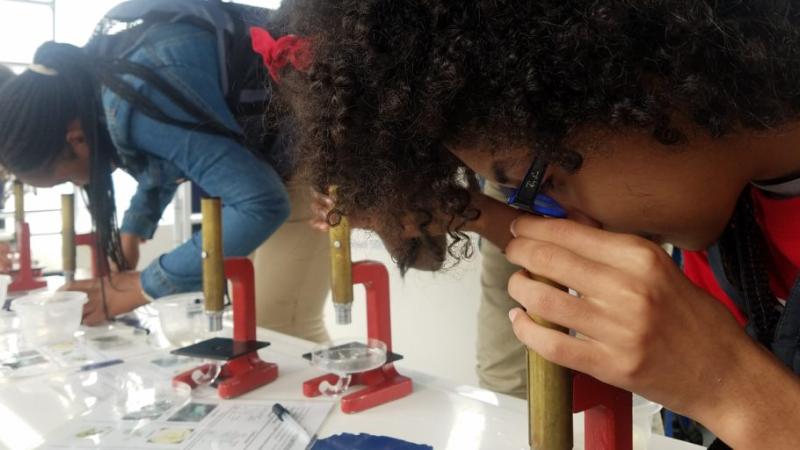July 6, 2018

[David Diehl, site manager and coordinator at the Rensselaer Darrin Fresh Water Institute (DFWI), recently organized a visit by students from Manhattan’s Harlem Academy to learn about the Jefferson Project at Lake George. In this guest post, he chronicles the three-day visit and the topics students learned about. The Jefferson Project is a collaboration between Rensselaer, IBM Research, and The FUND for Lake George, founded to develop a new model for technologically enabled environmental monitoring and prediction to understand and protect the Lake George ecosystem and freshwater ecosystems around the world. This is the third year Harlem Academy has visited DFWI.]
The Jefferson Project at Lake George recently hosted a group of eighth-grade students from Manhattan's Harlem Academy for three days in which they learned about lake stressors like salt and nutrient loading, and how advanced technology and big data are being used to protect these threats to water quality
The Jefferson Project— a partnership between IBM Research, Rensselaer Polytechnic Institute, and The FUND for Lake George—is building the world’s most advanced environmental monitoring system to better understand freshwater ecosystems and provide science-based insights to decision makers for sustained protection of Lake George, and lakes worldwide. The project’s research team includes more than 100 Rensselaer faculty, staff, and students—in areas including biological sciences, earth and environmental sciences, engineering, and the arts—combined with 20 IBM scientists and engineers and The FUND’s staff and scientific advisers. Since its inception in 2013, the project has built a Smart Sensor Network that gathers more than nine terabytes of physical and chemical data annually; computer models that depict the flow of water and threats throughout the watershed; surveys of plants and animals; and ongoing experiments to determine the impacts of human activities on the lake.
Sixteen students began their visit in May at the Aquatic Research Laboratory of Rick Relyea, the project director. At his lab in Rensselaer’s Tech Park, Relyea’s researchers introduced the Harlem students to the organisms that live in lakes, including zooplankton, macro-invertebrate animals, algae, and aquatic plants. The students explored how these organisms interact in a delicate balance within an aquatic food web, and how the stressors of salt and excess nutrients affect the food web and overall water quality. The students also visited the outdoor mesocosms—large tanks of water that simulate aquatic ecosystems—and they learned how to measure abiotic factors that support aquatic food webs such as dissolved oxygen and sunlight.
On day two, the students visited Rensselaer’s Darrin Fresh Water Institute (DFWI) in Bolton Landing, where they learned about the long history of DFWI researchers studying Lake George and other nearby watersheds. A tour of the labs at the DFWI provided an understanding of how different areas of lake and stream research require specific tools and expertise.
Next, students visited the Helen-Jo and John E. Kelly III ’78 Data Visualization Laboratory at DFWI for an overview of the Jefferson Project, including the computer models used to understand the complex interactions biological and abiotic factors—such as road salt—have on water quality. Students learned how nine terabytes of physical and chemical data collected by the project annually can be coupled with other technologies to control and limit the spread of road salt in sensitive areas or areas that do not need treatment at all.
The students rounded out the day with a tour aboard the Lake George Association’s Floating Classroom. While on the water, students collected zooplankton for microscopic study, conducted water clarity measurements using Secchi discs, and received historical anecdotes involving Lake George in the contexts of the French and Indian War and the American Revolution. On their final day at Rensselaer’s main campus, Harlem students presented their findings and what they learned during their experiences to their classmates.
My own work directing this part of their experience always makes me feel grateful to work with these students, as they always make compelling presentations, and answer thoughtful questions often in humorous and always meaningful ways.
The apparent success of this program would not be possible without the help of Rensselaer's Cynthia Smith, Rick Relyea, and Kayla Coldsnow, and the Lake George Association’s Walt Lender and Kristen Wilde. Many others are to thank for their help as well.
